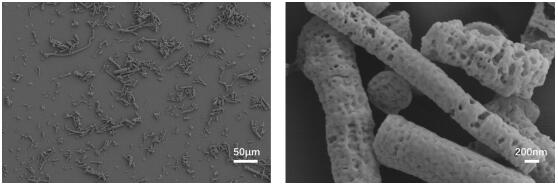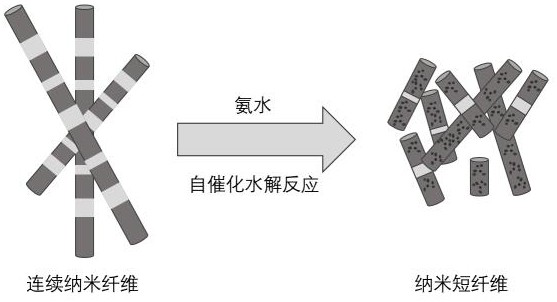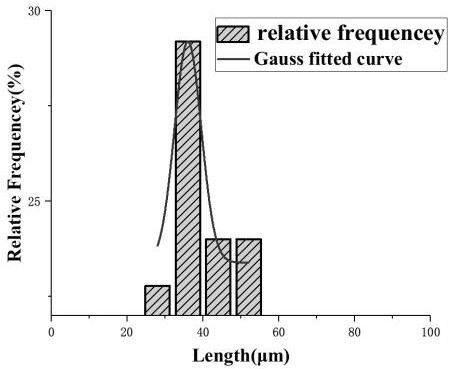A nano-short fiber material for tissue repair and its preparation method and application
A tissue repair and nanofiber technology, used in pharmaceutical formulations, prostheses, drug delivery, etc., can solve problems such as inability to adapt to minimally invasive surgery, and achieve the effect of maintaining biocompatibility, tissue repair performance, and good dispersion performance
- Summary
- Abstract
- Description
- Claims
- Application Information
AI Technical Summary
Problems solved by technology
Method used
Image
Examples
Embodiment 1
[0060] Embodiment 1 Preparation of polylactic acid nano short fiber material
[0061] This embodiment provides a short polylactic acid nanofiber material, which is prepared by the following method.
[0062] S1. Add 0.8g polylactic acid into 10ml hexafluoroisopropanol solution, stir at room temperature until dissolved, and make 8% (w / v) spinning solution;
[0063] S2. Add the spinning solution into the syringe, add an extension tube to the front end of the syringe and connect a 20G needle, place the syringe on the micro-injection pump, the needle is perpendicular to the receiving plate, and the lower part of the receiving plate is grounded; set the injection rate to 6ml / h, when When the solution is extruded from the needle tip, a voltage of 22kv is applied to the needle tip; at this time, nanofibers are ejected and collected on the receiving plate to form a nanofiber film;
[0064] S3. Vacuum-dry the nanofibrous membrane for 48 hours to remove hexafluoroisopropanol, then trans...
Embodiment 2
[0069] The preparation of embodiment 2 PLGA / gelatin nano-short fiber material
[0070] This embodiment provides a PLGA / gelatin nano-short fiber material, which is prepared by the following method.
[0071] S1. Add 1g of PLGA to 10ml of hexafluoroisopropanol solution, stir at room temperature until dissolved, then add 0.2g of gelatin, and dissolve to make a 10% (w / v) spinning solution;
[0072] S2. Add the spinning solution into the syringe, add an extension tube to the front end of the syringe and connect a 23G needle, place the syringe on the micro-injection pump, the needle is perpendicular to the receiving plate, and the lower part of the receiving plate is grounded; set the injection rate to 2ml / h, when When the solution is extruded from the needle tip, a voltage of 30kv is applied to the needle tip; at this time, nanofibers are ejected and collected on the receiving plate to form a nanofiber film;
[0073] S3. Vacuum-dry the nanofibrous membrane for 48 hours to remove he...
Embodiment 3
[0079] This embodiment provides a short polylactic acid nanofiber material, which is prepared by the following method.
[0080] S1. Add 0.8g polylactic acid into 10ml hexafluoroisopropanol solution, stir at room temperature until dissolved, and make 8% (w / v) spinning solution;
[0081] S2. Add the spinning solution into the syringe, add an extension tube to the front end of the syringe and connect a 20G needle, place the syringe on the micro-injection pump, the needle is perpendicular to the receiving plate, and the lower part of the receiving plate is grounded; set the injection rate to 6ml / h, when When the solution is extruded from the needle tip, a voltage of 22kv is applied to the needle tip; at this time, nanofibers are ejected and collected on the receiving plate to form a nanofiber film;
[0082] S3. Vacuum-dry the nanofibrous membrane for 48 hours to remove hexafluoroisopropanol, then transfer it to 25% ammonia water according to the mass-to-liquid ratio of 1:50, let i...
PUM
| Property | Measurement | Unit |
|---|---|---|
| diameter | aaaaa | aaaaa |
| length | aaaaa | aaaaa |
| length | aaaaa | aaaaa |
Abstract
Description
Claims
Application Information
 Login to View More
Login to View More - R&D
- Intellectual Property
- Life Sciences
- Materials
- Tech Scout
- Unparalleled Data Quality
- Higher Quality Content
- 60% Fewer Hallucinations
Browse by: Latest US Patents, China's latest patents, Technical Efficacy Thesaurus, Application Domain, Technology Topic, Popular Technical Reports.
© 2025 PatSnap. All rights reserved.Legal|Privacy policy|Modern Slavery Act Transparency Statement|Sitemap|About US| Contact US: help@patsnap.com



